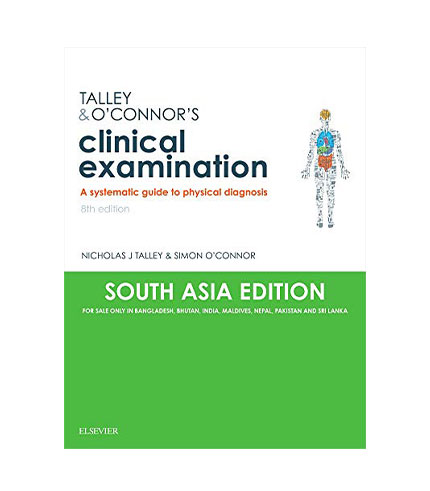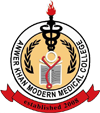Anwer Khan Modern Medical College
Library Management System

| Title: | Talley & O'Connor's clinical examination : a systematic guide to physical diagnosis |
| Author Name: | Nicholas Talley and Simon O'Connor |
| Author Sur Name: | TALLEY, Nicholas. |
| Author information: |
|
| Edition/Published: | 8th ed. _Australia : Elsevier , 2018 |
| New to this edition: |
|
|
Physical Description: : <p>xxiii, 888 pages : illustrations ; 26cm</p>.; |
| Notes | Includes bibliographical references and indexes |
| Includes Index: | 889-914 |
| ISBN No's: | 978-0-72954290-6 |
| Bar Code's: | |
| Shelf Location's: |
| Classification | |
| Subject: | Physical diagnosis |
| Dewey Class No: | 616.0754 |
| Other's Book Information | |
| Book ID No: | 2384 |
| Total Books: | 1 |
| Date of collection's: | 26-Dec-2018 |
| Language: | English |
| Status: | Available |
| Department: | Medicine |
| Synopsis: |
|
| Review: |
|
| Description: |
|
| Key Features: |
|
| Summary: |
Talley and O'Connor's Clinical Examination, 8th Edition is a comprehensive and up-to-date resource for students of clinical medicine. It provides students with the knowledge and skills they need to perform a thorough and accurate physical exam. The text is divided into two volumes: Volume 1 covers the general principles of clinical examination, including the history, physical exam, and correlation of physical signs with disease. Volume 2 covers the specific physical exam findings for each body system. Each chapter in the text begins with an overview of the relevant anatomy and physiology. This is followed by a discussion of the history and physical exam findings for the particular body system. The chapter concludes with a section on correlation of physical signs with disease. The text is well-organized and easy to follow. The illustrations are clear and helpful. The text is also up-to-date, reflecting the latest evidence-based research in clinical examination. Talley and O'Connor's Clinical Examination, 8th Edition is an essential resource for students of clinical medicine. It provides students with the knowledge and skills they need to perform a thorough and accurate physical exam. Here are some of the key features of the 8th edition: New evidence-based content: The text has been updated to reflect the latest evidence-based research in clinical examination. New clinical images: The text now includes over 200 new clinical images, which provide students with a clear and concise visual representation of the physical exam findings. New clinical videos: The text now includes over 50 new clinical videos, which provide students with a step-by-step guide to performing the physical exam. New clinical cases: The text now includes over 50 new clinical cases, which allow students to practice their clinical reasoning skills. New self-assessment questions: The text now includes over 200 new self-assessment questions, which allow students to test their knowledge of the material. In addition to these new features, the 8th edition of Talley and O'Connor's Clinical Examination has also been reorganized to make it easier for students to find the information they need. The text is now divided into two volumes: Volume 1 covers the general principles of clinical examination, and Volume 2 covers the specific physical exam findings for each body system. The 8th edition of Talley and O'Connor's Clinical Examination is a comprehensive and up-to-date resource for students of clinical medicine. It provides students with the knowledge and skills they need to perform a thorough and accurate physical exam. |
| Abstract: |
Talley and O'Connor's Clinical Examination, 8th edition, is a comprehensive guide to clinical examination for medical students, trainee doctors, and practicing clinicians. The book provides a practical approach to patient assessment, with a focus on evidence-based practice and clinical reasoning. In this edition, new sections on interpreting the chest X-ray and CT scan have been added, and there is expanded coverage of the cardiovascular system, including the jugular venous pulse. The book also includes new information on shared decision-making and the "N of 1" trial, as well as updates to examination techniques, with updated information on assessing the abdomen, peripheral vascular system, and lymphatic system. The 8th edition of Talley and O'Connor's Clinical Examination provides a comprehensive guide to clinical examination, with updated information and references reflecting current research and best practices in clinical examination. |
| Preface: |
Acquire the art of detachment, the virtue of method, and the quality of thoroughness, but above all the grace of humility. Ask not what disease the person has, but rather what person the disease has. Sir William Osler Welcome to the new edition of Clinical Examination, which has been carefully revised and updated. Clinical skills are the foundation of clinical medicine, most importantly history taking and physical examination. In most cases, a good history and physical examination will lead you to make the correct diagnosis, and this is critical—your diagnosis will more often than not seal the fate of your patient and, assuming you are correct, take them down the optimal management path. In order to make a correct diagnosis you need to assemble all the facts at hand. Blindly ordering tests in the absence of the clinical history and relevant examination often leads to serious errors. It is distressingly common for tests to be ordered and referrals made without an adequate history or even a cursory examination of the patient. The wrong diagnosis can cause harm and distress that lasts a lifetime. Clinical Examination is designed to take students on an exciting journey from acquiring core skills to an advanced level, applying a strong evidence-based focus. We have taken a systematic approach because recognition of all the facts aids in accurate diagnosis. The patient presenting with, for example, heart disease may have not only objective changes of disease when listening to the heart but also relevant findings in the hands, arms, face, abdomen, and legs that can guide the identification of the underlying disease process and prognosis. Diagnosticians are great medical detectives who apply rigorous methodology to uncover the truth, solve a puzzle and commence the healing process. Our book is not a traditional undergraduate textbook and we are proud of its distinctive features. Learning must be fun! Unlike most other similar textbooks, ours is deliberately laced with humor and historical anecdotes that generations of students have told us to enhance the learning experience. Another distinguishing feature is that every chapter in this book has undergone peer review, just as you would expect would occur for any published journal article. We have believed from the beginning that peer review is integral to ensuring the highest possible standards and maximizing the value of a core textbook. In this edition based on the peer review process, we have made revisions, excluded irrelevant material, and added updates where appropriate. Videos demonstrating techniques enhance the learning experience, and the e-book format supports learning from a tablet or computer anywhere and anytime. We are also proud of this book being current and as evidence-based as possible, with updated chapter references and annotations so readers can dive deeper into any of the literature that interests them. We want students at all levels to know there are many limitations and gaps (all crying out for more research), and to remain curious and excited about medicine as they learn. Clinical skills can be mastered only by practice and you should aim to see as many cases as you can while studying from this or any book. You will learn from your patients your entire career if only you take the time to listen and observe. Great clinicians are made not born, and everyone practicing medicine needs to master clinical skills. Thank you to all those who have provided us with expert input as we have made our revisions. We also thank all of our colleagues and patients who educate us daily, and the legion of students who have written to us, including those who have pointed out omissions or mistakes (real or perceived).
Nicholas J. Talley Simon O’Connor Newcastle and Canberra, July 2017 |
Related Books
- Davidson's principles and practice of medicine.
- Macleod's clinical examination
- Hutchison's clinical methods: an integrated approach to clinical practice
- Hutchison's clinical methods: an integrated approach to clinical practice.
- Davidson’s principles and practice of medicine.
- Davidson's principles and practice of medicine
- Rapid review of, clinical medicine
- Morgan & Mikhail's clinical anesthesiology.
- Talley & O'Connor's clinical examination : a systematic guide to physical diagnosis
- Macleod's clinical examination
